This page lists the activities presented by the project teams at the C4 meeting in Portugal, whose topic was teaching and learning outside school
Each team presented at least 2 activities, one in the Maths and Science category and one in Art and Humanities category.
SCIENCE and MATHS
SPAIN:
ITALY:
For the C4 topic "Teaching and Learning outside the school" our 4 students presented the results of a project that involved the little students of our school. "We are the band, the recycling band, every waste can be important ..." it is while rapping this tune that the children of the comprehensive Perri-Pitagora institute marched in procession animating the streets with the recycling parade of theater and music. The Recycling Band has been around with the aim of raising awareness among children of environmental sustainability issues and has seen the participation of over 1200 children and young people aged 6 to 13. The title of the "fight against small waste" project aims to highlight the problem of abandoning waste on beaches and in areas more subject to this type of environmental degradation.
In the previous days, school children took part in a series of creative recycling workshops which then culminated in the creation, thanks to the supervision of the artist Michele Evangelisti, of an artistic installation later placed in the courtyard of the Istituto Maggiore Perri. It all began with the collection of waste abandoned on the beach in Ginepri, with which the children created the artistic assemblage: plates, glasses, cans and much more, everything that was found on the beach ended up set in a petrified sand sculpture. Even musical instruments and masks were created by manipulating plastic, paper and cardboard. An interesting initiative that starts with the education of the little ones and then also makes adults aware of respect for nature. Because it is important to educate children, as they will be the future of the planet, but it is necessary to act quickly given the environmental emergency we are experiencing. So it is precisely the little ones, who learn to live civilly but also become the spokesperson for an important message, a real cry for help that they wanted to send out to the whole of society with this sound and super colorful performance.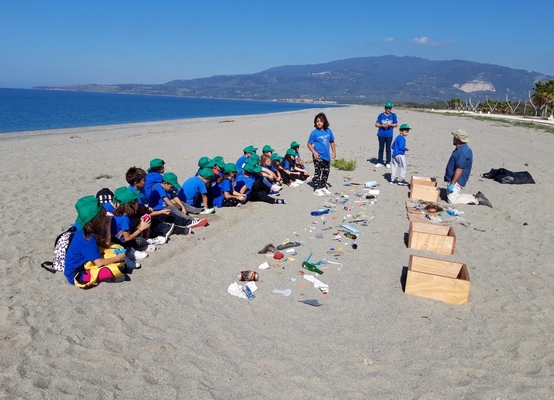
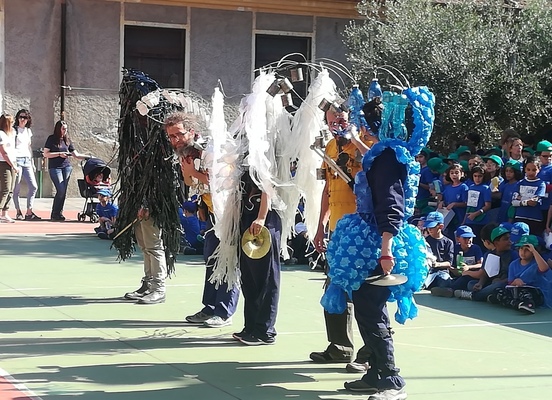
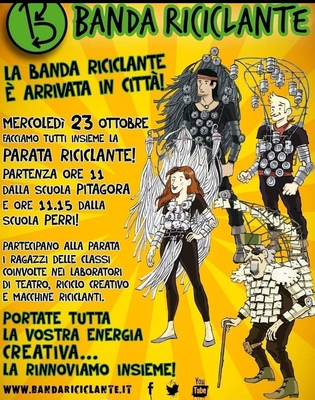
GREECE:
ROMANIA:
The visit to Portugal was a great experience in itself. Not surprisingly, the Portuguese landscape, the people and their language made us feel at home.
The project activities, which were hosted by Agrupamento Escolas Conde de Ourem, had as their main objective to improve the techniques teachers use in class and to encourage the use of modern teaching strategies, reinforcement and assessment methods so as to increase the students’ interest in the learning process and in school as a whole. During the three-day activities, the project teams proposed different teaching methods that can be useful for teaching science or humanistic subjects with the aid of ICT, online apps, and other modern software, all of which sparked the students’ interest and active participation.
The Romanian team tried once again in their presentations to cross the apparent barriers between the school subjects themselves on the one hand, and between school and real life on the other. Thus, art teachers experimented on using music as a source of inspiration for fine arts students, the result being a mix of musical harmonies on paper. In their turn, science teachers got the students out of the school precincts and asked them to apply mathematical notions for real so as to find the approximate height of the school. More than being fun, the activity pointed out once again that learning is done in so many ways, including outside the school environment. Hoping that this type of activities could be replicated by our foreign friends, we took home our own share of new insights into education.
There was still another gain in this mobility: the school trips the host school organised to Fatima (the Shrine dedicated to Virgin Mary), Coimbra (The University, the Library and St Michael’s Chapel, part of the World Heritage) and Tomar.

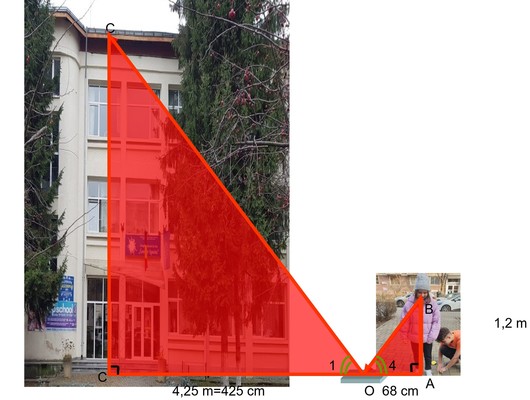
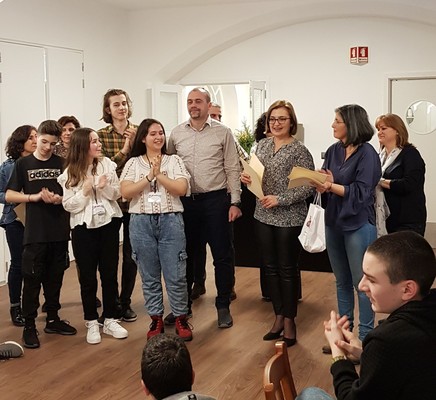
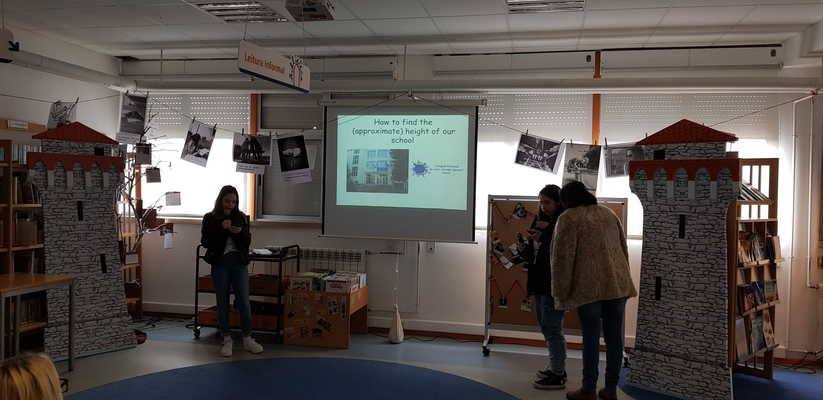
PORTUGAL:
Our students went on a school trip to the Science Centre in Constância where they have consolidated some physics knowledge.
Then they learned that the galaxy could have three different shapes (spiral, elliptic and irregular). Our galaxy (Milky way) is spiralling from earth; it looks like a bright, diffuse swath and the first four planets of the solar system are small and rocky and the others are giant and gaseous.
They also learned that the sun is a huge ball of gas about 1000 times larger than all the planets combined, and the mass of the sun represents 99% of the entire solar system. In the solar system the unit that we use is the astronomical units which is the distance between the sun and the earth which are approximately 150 000 000 Km.
They have explained that Planet Earth rotates around an imaginary axis that joins the North Pole to the South Pole. The rotation period of the Earth, which corresponds to a complete lap, lasts 24 hours and the position of the sun changes during those 24 hours.
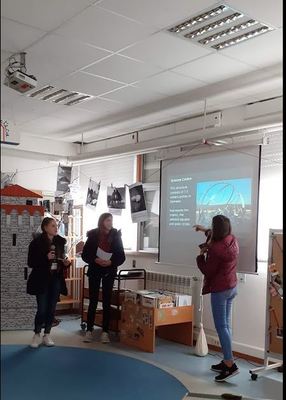
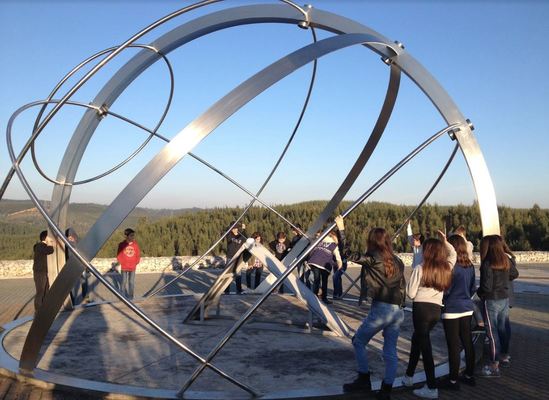
C4-Solar System.pptx
POLAND:
Learning Physics in the city
„We wanted to show you our ideas how to learn physics outside the school building. How many of you are struggling with learning physics? All these definitions, science formulas and strange words make us crazy. While making this project we discovered other ways to learn and we wanted to share this with you.
Our lesson combined 3 topics:
1 - Noise in the city – we talked about acceptable standards – are they exceeded? When do we feel pain when it is too loud?
2 - Differences between kinetic and potential energy.
3 - A closer look at elevators speed. Does height of a building influence the elevators speed?
We start with the volume of noise in the city. We checked what a decibel (dB) is and learned about acceptable noise in the city emitted by street and railway in daytime (70dB ) and at night (65dB). Acceptable noise in city emitted by other objects e.g factories is – daytime 55dB – and at night 45Db. Then we went to a few places in Warsaw where we measured the level of noise: Warsaw Central Railwaystation, the shopping centre Złote Tarasy, a crossing of two big streets in Warsaw ( one of the loudest places in Warsaw because of people going to work, public transport, cars and people performing on the streets) and the underground station. To measure volume level we used ‘’ Decibel x ‘’ application. We also made videos at each location to show you the results.
Next we talked about „the swing observation” but first we explained what the kinetic and the potential energy are. We used some schemes and drawings to ilustrate the difference. Then we went to a park to practice. And again we made video shows how kinetic and potential energy works and presented the formulas which we used to calculate these energies.
Finally, we went to the Palace of Culture and Science in Warsaw, which is one of the most recognisable signs of Warsaw and it’s also the highest building in Poland (237m). we went there to see conduct our observations of lifts speed. Here you can find our measurement results: two lifts move with speed 6m/s. and they reach 30th floor in 19 seconds, 6 lifts riding with the speed 3,5 m/s, which can reach 27th floor and 4 other lifts which can reach 13th floor, and they move with speed of 2,5 m/s. In our presentation we enclosed the video from elevator which we took to the observation deck. We decided to do two more observations: how fast lifts in blocks of flats are and why bottle changes it’s weight while riding in a lift. We made a video on which you can see how the weight of the bottle changes when the elevator starts going down or going up. From our observations we could conclude that weight increases when elevator starts going up or elevator brakes on its way down and weigh declines when elevator starts going down or elevator brakes on its way up. Our observations showed that we are pressed to the floor when lift starts going up and when it brakes while going from top to the bottom and we are pushed off the floor when elevator goes down or when it brakes while going up.
Our simple observations helped us to understand the physical formulas and we think it is easier to learn such a hard subject as science when we have a chance to experience all this that we are taught at school.” Gabrysia and Zosia
Physics C4.pptx
ART and HUMANITIES
SPAIN:
ITALY:
As part of the topic "Learning outside the school" we presented the results of a project that involved the students some months ago :"Ciak ...( 1,2,3 action) a simulated process to avoid a real one".
The simulated process is part of a broader program envisaged by the educational offer of the institute to help students achieve goals of citizenship and respect. Through activities in the classroom, meetings with figures of the police, the advocacy and the judiciary, we are committed to training our students in a culture of respect for others and respect for the rules, in a healthy use of modern tools of communication, fundamental conditions for preventing phenomena such as bullying and cyberbullying which, as in the story simulated by our students, are the result of a freedom freed from responsibility and respect. As a school we feel the duty not only to transmit notions, but to activate responsible citizenship paths for our students. 
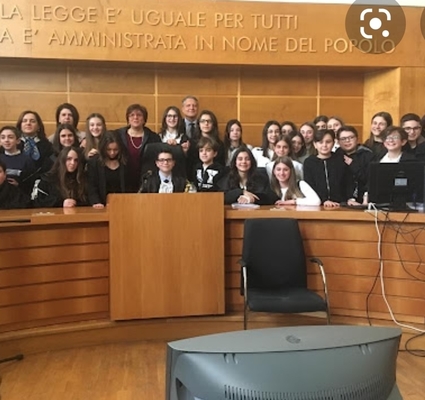
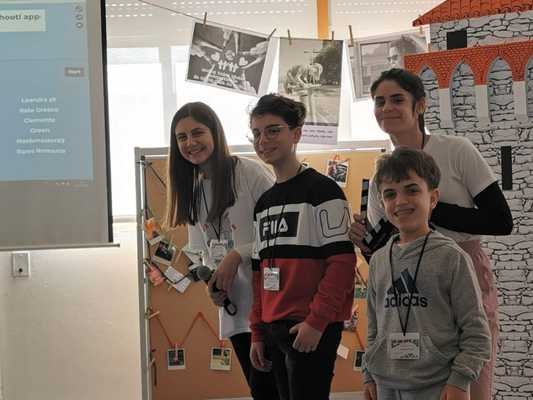
GREECE:
ROMANIA:
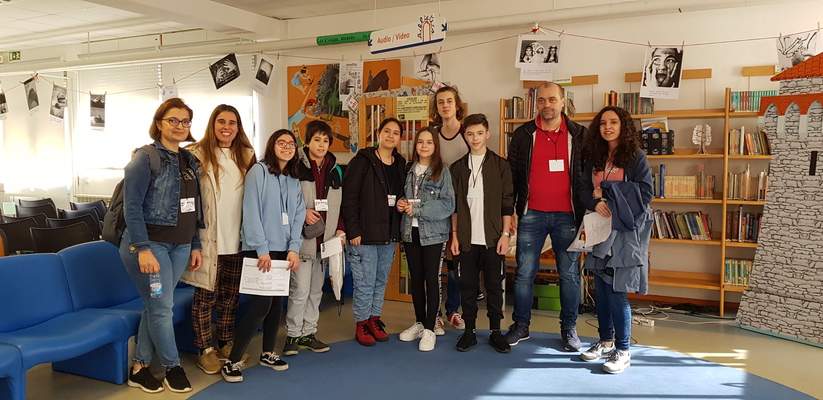
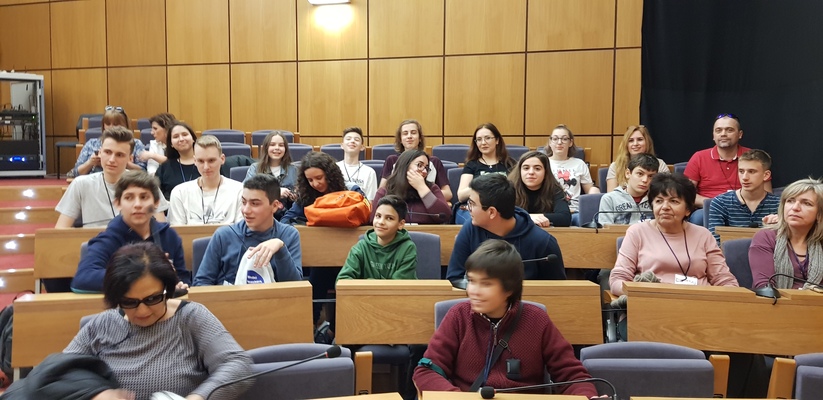
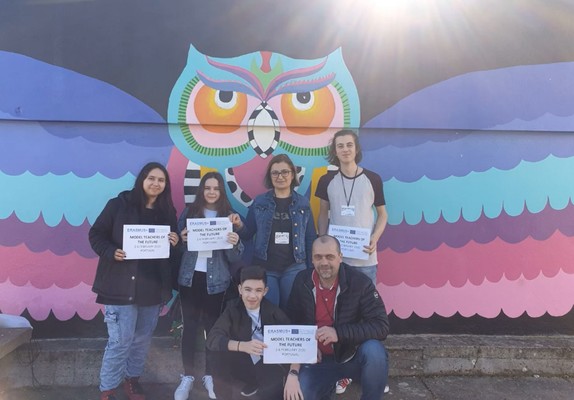
PORTUGAL:
In this work, presented in Portugal by the 7th year students in 2018, we talked about learning outside school and we visited the firefighters’ headquarters.
We covered several topics that we thought were important, such as:
Fires in Australia; Fires in Portugal; Fire vocabulary; Volunteer firemen from Ourém;
Objectives of this project; Contributors for this project; How it started (this project);
The first, second, third and fourth activities;
And the conclusion.
Through this work, we wanted to show how important firefighters are in society because they do everything to help other people, as their motto says: "a life for a life".
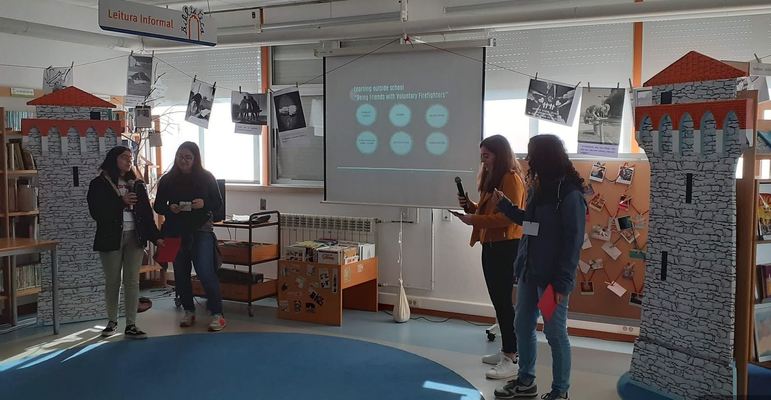
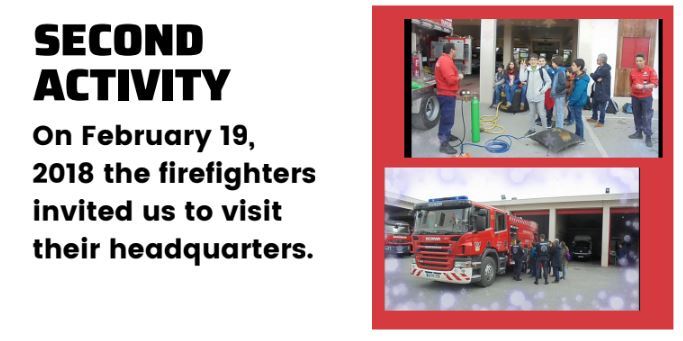
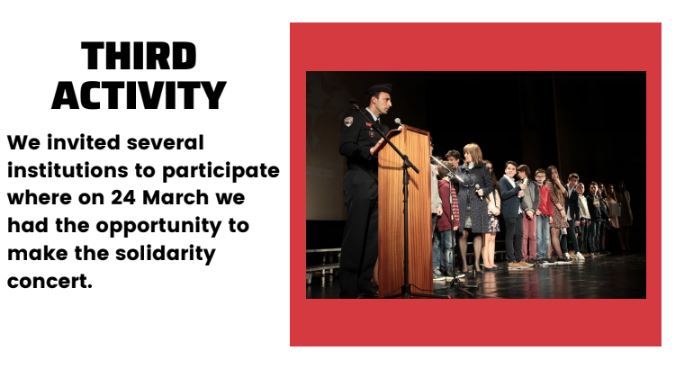
C4- Firefighters.pdf
POLAND:
The Vistula River as the backbone of Warsaw
-a cross curricular lesson during a walk along the Vistula River in Warsaw
"We wanted to show you an idea of a lesson outside the school building.
It was a walk along the Vistula River in Warsaw which was a cross curricular lesson combining a few subjects: Geography, Biology, History and Art.
Geography
Before the walk we needed to present to our class some general facts about the river. We decided to search the Internet, study maps and historical sources. Then we prepared a short presentation to our classmates. We wanted to prepare them for the walk, to show them what they should pay attention to during our lesson outside the school building. We told them that the walk would cover 4 subjects. We also gave our classmates some questions that we wanted to study, analyse or check during the walk. For example we noticed that the right side of the Vistula river is not urbanised. We discussed this issue with our friends and tried to find answers to this question.
Biology
Thanks to the fact that the right bank of the river is still wild we could come to the second subject of our lesson, namely biology. During our earlier presentation given in the classroom, we talked about the variety of birds living and nesting on the Vistula. We also informed our students about Natura 2000 programme. During the walk we had a chance to observe at least some of the protected species of birds, for example gulls and terns. Together with our classmates we studied information presented on the information boards located along the river. We learnt that about 50 species of birds nest in the central Vistula Valley.
History
The Vistula flows through the capital city of Poland , Warsaw and it has the historical meaning to people living there. Before the walk we had a discussion on how important the river is. We talked about the bridges, both the old and modern ones, the ports on the banks of the river, about the symbol of Warsaw - the Warsaw Mermaid. During the walk we went to the Mermaid statue and told the students the story of this monument. There is the Old Town on the left bank of the river but we wanted to concentrate on something less obvious. Before the walk we told in the classroom about droughts and floods that happen from time to time and during the walk we wanted our students to find treasures that were hidden in the river. It was a kind of a game. Our classmates found the board informing about the drought in 2015 and the record low level of water in the river. Thanks to this situation the entire base of objects and artifacts , which had been sunk for more than 400 years, were revealed.
Art
History is strictly connected with the Art and architecture is a part of the Art. We showed our friends 3 out of 9 bridges that are located in Warsaw. Each of them differs in style, age, function. You should know that although at least one of them looks really old, in fact it was only rebuilt after World War II, as all the bridges in Warsaw were destroyed during the war. We wanted students to look at them as the architectural structures, to observe important elements . And , for example, we could notice that some of them are beautifully illuminated with national colours or with the neons such as “miło Cię widzieć” which means “nice to see you”.
As you could see on our presentation the weather during our walk was rather harsh: cold, windy, snowy. But it did not stop us from having the lesson outside the school building. After the walk we asked our classmates what they think about this form of learning and what we got as a feedback was pretty optimistic. Everybody thought that the lesson was successful, that this form of getting knowledge is more attractive, efficient and funnier. For us it was a good fun and a lesson on how to teach and learn many subjects outside the school building." Grzegorz and Michał
The Vistula river.pptx